

Solids, liquids and gases (Outstanding Lesson) Cells 2: The Cell as a System. Photo credit: Clipart.com Purpose To review cell structures and investigate how the components of a cell operate as a system.
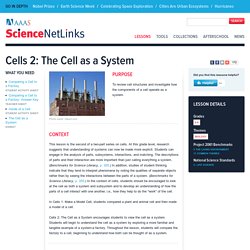
Context This lesson is the second of a two-part series on cells. Cell Biology. Cell Parts Cheek Cell Lab - observe cheek cells under the microscope Cheek Cell Virtual Lab – if you missed it in class Animal Cell Coloring.
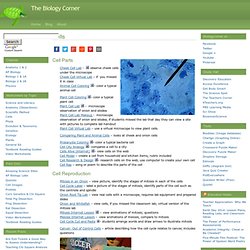
Www.biologycorner.com/worksheets/cellmodel.html#.U6A1aPl_tic. Purpose: The purpose of this project is to make a 3D model of a cell in order to better understand the parts and workings of a cell.
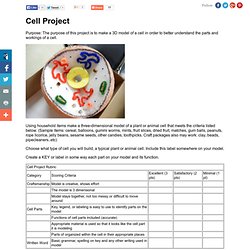
Using household items make a three-dimensional model of a plant or animal cell that meets the criteria listed below. Plant Cell Lab - Onion and Elodea. Name:______________________________________________ Purpose: Students will observe plant cells using a light microscope.
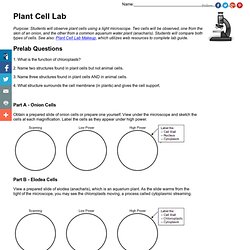
Two cells will be observed, one from the skin of an onion, and the other from a common aquarium water plant (anacharis). Cheek Cell Lab. Name: ____________________________________ 1.

Cbscience.weebly.com/uploads/1/0/7/1/10716575/ks3-wrksht.pdf. Www.psqm.org.uk/docs/_case_cpd_1_.pdf. BCS1 Living or non-living. What is the difference between living and non-living?

All living organisms display common characteristics of life which distinguish them from non-living things. All living things can move, respond to the world around them, need food, get energy from food, get rid of waste, grow and reproduce, although in some cases they may not show these life processes in an obvious way. Learning Intention Students should understand how living things differ from non-living things (because they move, respond to the world around them, need food, get energy from food , get rid of waste, grow and reproduce, although in some cases they may not show these life processes in an obvious way). "Grade 6-8 Living Things" by Theresa Gomez. "Grade 6-8 Living Things" by Theresa Gomez. Www.mensaforkids.org/lessons/cell/mfklessons-cell-all.pdf.
Www.nctt.net/lessons/plantani/AniPlaCells.pdf. The Structure of a Leaf. Science Teaching Resources: Lesson Plan Resources for Science Teachers. Below are free science teaching resources for teachers in UK schools to help you save time spent on lesson planning for Key Stages 1, 2, 3 and 4.
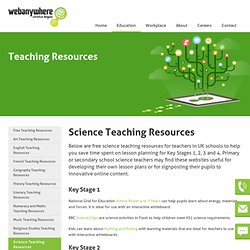
Primary or secondary school science teachers may find these websites useful for developing their own lesson plans or for signposting their pupils to innovative online content. Key Stage 1 National Grid for Education School Power 4 to 7 Years can help pupils learn about energy, materials and forces. It is ideal for use with an interactive whiteboard. BBC Science Clips are science activities in Flash to help children meet KS1 science requirements. Kids can learn about Pushing and Pulling with learning materials that are ideal for teachers to use with interactive whiteboards.
Key Stage 2 Produced by Cambridge University, Engineering Interact helps to make learning about science fun for 9 to 11 year olds. The Energy Experience teaches children about energy use in the home, with much about efficiency. Key Stage 3 Key Stage 4. Index page. Enercities. Www.sector39.co.uk/resources/CompostingPackKS2.pdf. Www.hackney.gov.uk/Assets/Documents/schools-composting-pack.pdf.pdf.
Great Vegetable Seeds from The Real Seed Catalogue. The Great Plant Escape. How to start plants from seed indoors to transplant in the garden later. Andrea Levy, The PD With visions of plump, juicy tomatoes, crisp cauliflower and sunny marigolds dancing in their heads, some gardeners spend late winter sowing seeds indoors and pampering their emerging beauties until it's warm enough to move them outdoors.

These indoor gardeners like to get growing early for several reasons. One, a packet of a dozen or so seeds, which costs a few dollars, is a fraction of what ready-to-plant botanicals cost. "It's cheaper than buying flowering plants and vegetable starts," says Christine Harris, an Ohio State University Extension Cuyahoga County master gardener, who won the statewide award of volunteer of the year at the International Master Gardener Conference in Charleston, W.V., last year. "Costs for these have skyrocketed due to fuel costs in greenhouses and for transportation. " Harris, who has been starting seeds indoors for about 13 years, says she has discovered a lot of vegetables and flowers that are not available at local greenhouses. Materials. Parts of Plants. Each part of a plant has a very important function.
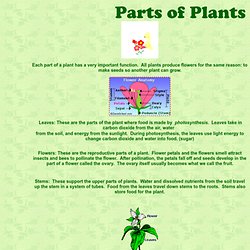
All plants produce flowers for the same reason: to make seeds so another plant can grow. Leaves: These are the parts of the plant where food is made by photosynthesis. Leaves take in carbon dioxide from the air, water. Plants Science Fair Projects for Kids - Easy Ideas, Botany, Soil, Grow Seeds. Where the Wonders of Learning Never Cease. Plant Cell Vs. Animal Cell. The bodies of both plants and animals are made up of cells.
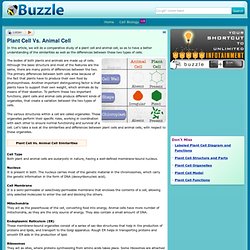
Although the basic structure and most of the features are the same, there are many points of differences between the two. The primary differences between both cells arise because of the fact that plants have to produce their own food by photosynthesis. Another important distinguishing factor is that plants have to support their own weight, which animals do by means of their skeleton. Science Online Living Things. Sheppard Software's Life-Cycles: Learn about different animal life-cycles. Tadpole (baby frog) Life Science. Boy with "green stuff" Learning Goals During this session, you will have an opportunity to build understandings to help you: Distinguish between living, dead, and nonliving Define the characteristics of life Video Overview What is life?
Video Outline We open with a look at environments where you wouldn’t expect to find life and pose this question: "If you are looking for life, what do you look for? " The program continues as children in grades two and three are presented with a challenge: group objects as living, dead, or nonliving. In Brooklyn, New York, we visit LauraJo Kelly and her second-grade students as they generate their own definitions of living, dead, and nonliving and proceed to design experiments to test whether a “mysterious” object is alive.
Our search for an answer to the question "What is life? " Life Cycle of Butterflies and Moths. Butterfly Life Cycle: Article with Lots of Pictures. Bees in Hive The Butterfly Life Cycle Let’s explore a butterfly’s life cycle in detail, including all four stages of life. All butterflies have "complete metamorphosis. " To grow into an adult they go through 4 stages: egg, larva, pupa and adult. Each stage has a different goal - for instance, caterpillars need to eat a lot, and adults need to reproduce. Butterfly Eggs on a Leaf. The Carbon Cycle. The Animal Kingdom - Vertebrates and Invertebrates. Animal Science Fair Projects for Kids - Fun Easy Ideas, Dogs, Cats, Fish. Animal articles, quizzes, facts and much more.